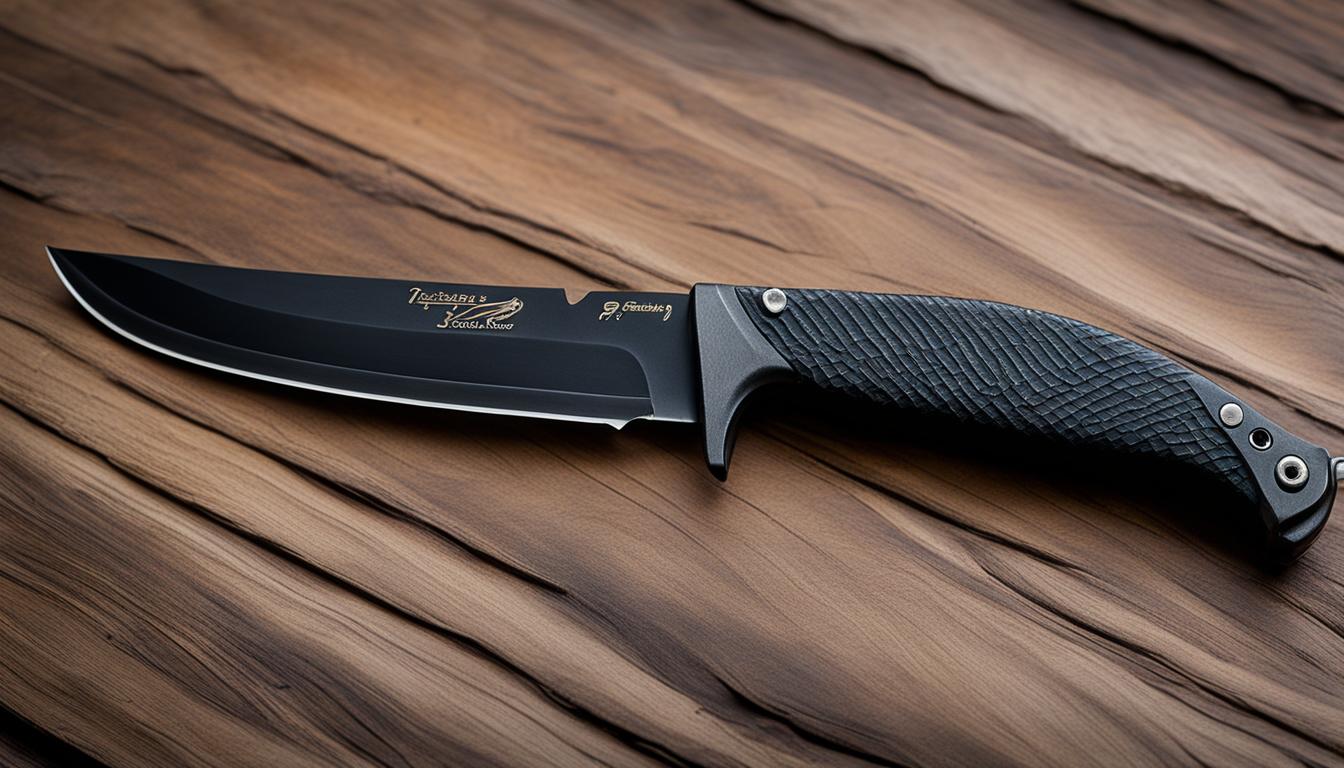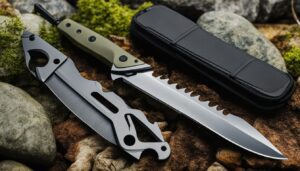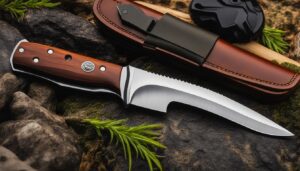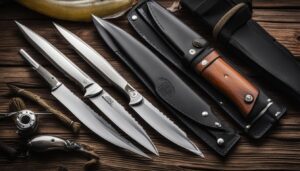Fishing knives are indispensable tools for outdoor enthusiasts, specifically designed for the intricate task of filleting and cleaning fish. They have a long, slender, and flexible blade that allows for precise filleting and minimal meat wastage. The blades are often made of stainless steel, which provides durability and corrosion resistance, important for fishing in wet conditions. The handles are designed for a secure grip, even when hands are wet or slimy. Fishing knives are versatile and can be used for various outdoor tasks, such as cutting bait and preparing meals at a campsite. They are a must-have tool for any angler or fisherman.
Key Takeaways:
- A fishing knife is a specialized tool designed for filleting and cleaning fish.
- The long, slender, and flexible blade of a fishing knife allows for precise filleting.
- Stainless steel blades provide durability and corrosion resistance.
- The handles of fishing knives are designed for a secure grip, even when hands are wet or slimy.
- Fishing knives are versatile and can be used for various outdoor tasks.
Types of Fishing Knives
Fishing knives come in various types, each designed to cater to different fishing needs. Here are the four main types of fishing knives:
1. Flexible Fillet Knife
The flexible fillet knife is known for its precision in filleting fish. Its thin and flexible blade adapts to the shape of the fish, allowing for clean and precise cuts along the bones. This type of knife is perfect for delicate filleting tasks, minimizing meat wastage.
2. Fixed Blade Fishing Knife
The fixed blade fishing knife is a sturdy tool, equipped with a non-folding blade. This type of knife is ideal for heavy-duty tasks such as cutting through tough scales and bones. The fixed blade ensures durability and reliability, making it a popular choice among anglers who require a robust fishing knife.
3. Folding Fillet Knife
The folding fillet knife is a compact and portable option, featuring a hinged blade that can be easily folded and stored. This type of knife is perfect for anglers on the go, as it takes up minimal space in their fishing gear. Despite its foldable design, the folding fillet knife still offers precision and versatility in filleting fish.
4. Electric Fillet Knife
The electric fillet knife operates using electricity, providing effortless filleting for frequent fish cleaning. This type of knife is equipped with a motorized blade that rapidly moves back and forth, making the filleting process quick and efficient. The electric fillet knife is a popular choice among professional anglers or those who frequently catch and clean large quantities of fish.
Choosing the right type of fishing knife depends on personal preference, fishing style, and the type of fish being caught. It’s important to consider the specific needs and requirements of your fishing adventures to ensure you have the most suitable tool for the job.
Table: Comparison of Fishing Knife Types
| Type | Features | Advantages |
|---|---|---|
| Flexible Fillet Knife | Thin and flexible blade | Precise filleting, minimal meat wastage |
| Fixed Blade Fishing Knife | Sturdy non-folding blade | Heavy-duty tasks, durability |
| Folding Fillet Knife | Compact and portable, hinged blade | Convenience, versatility |
| Electric Fillet Knife | Motorized blade | Efficiency, effortless filleting |
Advantages of Using a Fishing Knife
Using a fishing knife offers several advantages. Firstly, fishing knives allow for precise filleting of fish. With their long, thin, and flexible blades, they make clean cuts along the bones, ensuring minimal wastage of meat. The precise filleting capability of fishing knives enables anglers to achieve professional-level results, whether they are preparing fish for cooking or saving the catch for later.
In addition to precise filleting, fishing knives make the cleaning process easier. They efficiently remove scales, innards, and fins, making the task quicker and more efficient. This not only saves time but also ensures a clean and hygienic fish preparation process, minimizing the risk of contamination.
Furthermore, fishing knives are versatile tools that offer more than just filleting and cleaning capabilities. They can be used for various outdoor tasks, such as cutting bait and preparing meals at a campsite. This versatility makes them an essential tool for any angler or fisherman, as they can serve multiple purposes during fishing trips and outdoor adventures.
Another advantage of using a fishing knife is the durability and corrosion resistance they provide. Fishing knives are designed to withstand harsh outdoor conditions, including exposure to water and moisture. Made with high-quality stainless steel blades, they are resistant to corrosion, ensuring they stay in optimal condition even in wet environments. This durability and corrosion resistance make fishing knives reliable tools that can withstand rigorous use over time.
Precise Filleting
- Long, thin, and flexible blades for clean cuts along the bones
- Minimizes meat wastage
Easy Cleaning
- Efficiently removes scales, innards, and fins
- Ensures a clean and hygienic fish preparation process
Versatility
- Can be used for various outdoor tasks
- Cutting bait, preparing meals at a campsite, and more
Durability and Corrosion Resistance
- Designed to withstand harsh outdoor conditions
- High-quality stainless steel blades
- Resistant to corrosion
In addition to the above advantages, fishing knives provide handle comfort and grip, come in different blade length options to cater to different fish sizes, are easy to sharpen, and are portable for on-the-go use. With all these benefits, it’s clear why a fishing knife is a valuable tool for any angler or fisherman.
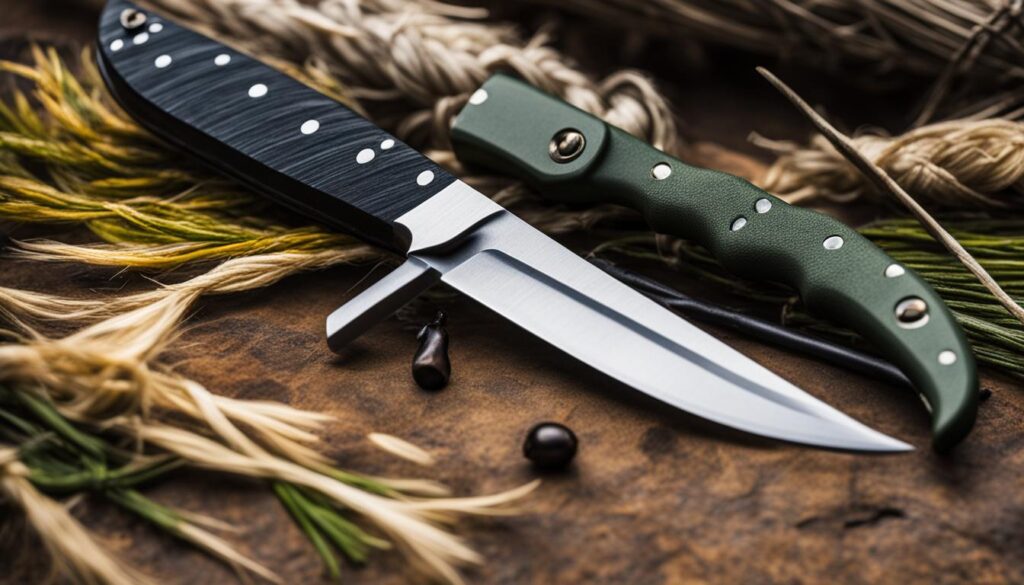
| Advantages of Using a Fishing Knife |
|---|
| Precise filleting |
| Easy cleaning |
| Versatility |
| Durability and corrosion resistance |
| Handle comfort and grip |
| Blade length options |
| Easy to sharpen |
| Portability |
Qualities of a Good Fishing Knife
A good fishing knife should possess several important qualities to ensure optimal performance when filleting and cleaning fish. These qualities include the blade material, blade type, blade length, corrosion resistance, and blade sharpness.
Blade Material
The blade material of a fishing knife is crucial for its durability and corrosion resistance. Stainless steel is a popular choice among anglers due to its ability to withstand wet conditions and resist rust. It provides a long-lasting blade that remains sharp and efficient even after prolonged use.
Blade Type
The blade type of a fishing knife is another vital consideration. A flexible blade is highly recommended for precise filleting, as it allows for easy maneuvering around the bones and contours of the fish. Thin and bendy blades are commonly used in fishing knives to achieve clean and accurate cuts.
Blade Length
The blade length of a fishing knife should align with the size of the fish being filleted. Smaller fish typically require shorter blades for precise cuts, while larger fish benefit from longer blades to handle their size and thickness. Choosing the appropriate blade length ensures optimal performance and efficiency when filleting different fish species.
Corrosion Resistance
Corrosion resistance is a crucial quality for a fishing knife, as it ensures the blade remains in good condition even when exposed to water and moisture. A fishing knife with corrosion-resistant properties not only extends its lifespan but also ensures optimal performance during fishing trips in wet and humid environments.
Blade Sharpness
Blade sharpness plays a vital role in achieving clean and precise cuts when filleting fish. A good fishing knife should have a sharp blade that retains its sharpness over time. Regular sharpening and maintenance are necessary to ensure that the blade remains in optimal condition for effortless filleting.
Investing in a fishing knife with these qualities will provide anglers with a reliable and efficient tool for filleting and cleaning fish. The right blade material, type, length, corrosion resistance, and sharpness are all essential factors to consider when choosing a fishing knife that suits your specific needs.
Conclusion
Fishing knives are essential tools for outdoor enthusiasts like me who enjoy hunting and fishing. Designed specifically for filleting and cleaning fish, these knives offer precision and versatility. Whether you’re an angler or a fisherman, investing in a high-quality fishing knife with a sheath is a wise decision.
One of the key advantages of using a fishing knife is the precise filleting it offers. The long, thin, and flexible blade allows for clean cuts along the bones, ensuring minimal wastage of meat. Cleaning fish becomes effortless with a fishing knife, as it efficiently removes scales, innards, and fins.
Durability and corrosion resistance are crucial for fishing in wet conditions. Fishing knives are designed with stainless steel blades that resist corrosion, ensuring they stay in good condition over time. Additionally, the handles of fishing knives provide comfort and a secure grip, even when your hands are wet or slimy.
Portability is another important aspect of fishing knives. They are easy to sharpen and maintain their sharpness for precise cutting. This makes them convenient for anglers on the go. So, whether you’re planning a fishing trip or simply enjoy outdoor cooking, a fishing knife is a must-have tool in your arsenal.
FAQ
What is a fishing knife?
A fishing knife is a specialized tool designed for filleting and cleaning fish. It has a long, slender, and flexible blade that allows for precise filleting and minimal meat wastage.
What are the types of fishing knives?
There are several types of fishing knives available, including flexible fillet knives, fixed blade fishing knives, folding fillet knives, and electric fillet knives. Each type has its own advantages and is suited for different fishing needs.
What are the advantages of using a fishing knife?
Fishing knives offer precise filleting, easy cleaning, versatility, durability, and corrosion resistance. The handles provide comfort and grip, while the blade length options cater to different fish sizes. Fishing knives are also easy to sharpen and portable, making them convenient for anglers on the go.
What qualities should a good fishing knife have?
A good fishing knife should have a blade made of corrosion-resistant material, a flexible blade for precise filleting, an appropriate blade length for the size of fish being filleted, and a sharp edge for clean and precise cutting.
